Papers by Kuntala Lahiri-Dutt
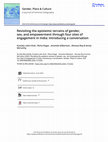
Gender, Place & Culture, 2020
Knowledges that claim to end oppression and marginalization frequently end up feeding the same hi... more Knowledges that claim to end oppression and marginalization frequently end up feeding the same hierarchies that produce those oppressions. In the academy and in the development industry, it is not uncommon for ‘local’ or ‘subaltern’ knowledges to be positioned as ‘raw data’ to be utilised by the formally certified intellectual or expert, and even presented sometimes as obstacles to development goals that may have been imported from elsewhere . This introduction serves as an opening to a ‘conversation’ among five scholars who have different yet overlapping engagements with the complex terrain of knowledge-making on sex and gender, based on their long-term work in India. The conversation interrogates the knowledge hierarchies that are implicit in the way gender, sex, sexuality and empowerment are conceived, presented and pursued by scholars and practitioners in development studies. Through four essays, each of them followed by a written exchange among authors, we jointly consider the ...
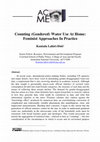
ACME: An International Journal for Critical Geographies, 2015
In recent years, international policy-making bodies, including UN agencies and major donors, have... more In recent years, international policy-making bodies, including UN agencies and major donors, have been vocal in demanding gender-disaggregated water-use data, a requirement that is also receiving attention in academic research. Although the data sought is presumably macro-scale official statistics of sectoral water consumption divided into male/female categories, the structure of such data and the means of collecting them remain unclear. The demand for gender-disaggregated data has arisen at a time when feminists have urged researchers to exercise caution in how they generate data, what might be considered as data, and what that information signifies to the users. Feminist scholars also caution against the “knowledge effect” produced by numerical data: an overwhelming conversion of complicated and contextually variable phenomena into unambiguous, clear, and impersonal measurements. Heeding their concerns, I argue in this article that the generation of official statistics cannot be t...

This chapter addresses three key research questions often posed in fieldbased and participatory d... more This chapter addresses three key research questions often posed in fieldbased and participatory development research: how to effectively integrate Monitoring and Evaluation (M&E) into the project cycle; how to integrate a gendered approach to participatory surveys; and how to use an assets-based approach as opposed to a conventional needs-based assessment. The innovation in this chapter lies in the use of a recently developed asset-based participatory M&E method (Livelihood Asset Status Tracking or LAST), in combination with gender analysis, undertaken by participants to examine the impacts of community development projects on women and men in a coal mining region of East Kalimantan, Indonesia. The work was undertaken in and around the areas of operation of PT Kaltim Prima Coal (KPC) in Sangatta, East Kalimantan, as part of an Australian Research Council-funded Linkage Project. The Australian National University (ANU) and PT Kaltim Prima Coal are joint project partners.
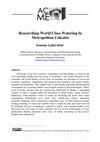
ACME: An International Journal for Critical Geographies, 2015
Enormous social and economic inequalities notwithstanding, a colossal and ever-expanding middle-c... more Enormous social and economic inequalities notwithstanding, a colossal and ever-expanding middle-class has come to symbolise a new India. Because of the economic and social fluidity of this class, its members are prisoners of social and economic aspiration, negotiating and manoeuvring imagined and actual worlds, tradition and modernity. This middle-class is reinventing individual and household consumption by accessing hitherto out-of-reach resources and technologies. Water as an everyday resource has not escaped this whirlwind of change; a substantial volume of water is caught within the interstices of urban homes, where western-influenced, water-intensive forms of living are becoming the norm. New water consumption technologies now adorn most middle-class homes, indicating residents’ changing values and practices regarding water. As these practices change existing meanings of water and redefine what is meant by pure and clean water fit for drinking, the new technologies required to ...
w w w .a s h g a te .c o m w w w .a s h g a te .c o m w w w .a s h g a te .c o m w w w .a s h g a... more w w w .a s h g a te .c o m w w w .a s h g a te .c o m w w w .a s h g a te .c o m w w w .a s h g a te .c o m w w w .a s h g a te .c o m w w w .a s h g a te .c o m w w w .a s h g a te .c o m w w w .a s h g a te .c o m w w w .a s h g a te .c o m w w w .a s h g a te .c o m w w w .a s h g a te .c o m w w w .a s h g a te .c o m
Chars are pieces of land that rise temporarily from river-beds in South Asia only to disappear at... more Chars are pieces of land that rise temporarily from river-beds in South Asia only to disappear at the whim of the Monsoon Rivers. Chars exist in the vocabulary neither of those who study rivers, nor those who study islands, and have largely remained beyond the mainstream discussions on nature/culture. As analytical constructs and as real life examples of hybrid environments, chars have the potential to extend several theoretical boundaries. This paper presents chars as both the products of ecological processes of floodplain processes and delta building, and the processes of historical developments in colonial and post-colonial land and water management, and offers an outline of char environments, their people and their livelihoods in South Asia.
The Journal of Peasant Studies, 2021
Drawing on the findings of an extensive questionnaire-based survey conducted in two Indian states... more Drawing on the findings of an extensive questionnaire-based survey conducted in two Indian states of West Bengal and Gujarat, this paper investigates whether the concentration of women's labour contributions to agriculture has improved their autonomy in decision-making. It shows that women's labour burdens have increased without associated benefits, and raises the question of the invisibility of the 'preparatory work' that women do on and off the farm to support agriculture. The findings lead to the conclusion that for farming in India to thrive and ensure fulfilling lives for women farmers, the policymakers need to address rural women's discontent.
Ecology, Economy and Society–the INSEE Journal, 2020
This paper examines the ways in which knowledge about water has conventionally been generated by ... more This paper examines the ways in which knowledge about water has conventionally been generated by modern water scientists and illuminates how this approach leaves out the diverse “ways of knowing” water and how scientism creates a trap of concrete evidential certainty. Through the example of a failed conversation, it questions the basic epistemological underpinnings of understanding water in modern scientific inquiries—the means of knowing rivers, and how they conflict with feminist epistemologies and fail to account for the “knowledge others” and “others’ knowledge”. The paper concludes with observations on why we need new epistemologies of water in the Anthropocene.
Ecology, Economy and Society–the INSEE Journal, 2020
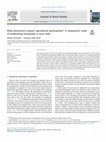
Journal of Rural Studies, 2020
This paper examines the key socioeconomic and cultural-demographic factors that determine rural w... more This paper examines the key socioeconomic and cultural-demographic factors that determine rural women's labour contributions in agriculture in India, both on family farms (either as cultivators or as family labour) and as agricultural wage labourer. Based on the analysis of primary data derived from a survey of 800 households from the two Indian states of Gujarat and West Bengal, it establishes that women's work in the farm sector cannot be homogenized. Women's work as additional hands in family farms differs from that as wage labourers which is casual in nature; their work also differs across different regions. In the commercialized, relatively more developed state of Gujarat, women's labour contributions are significantly different from West Bengal's less commercialized agrarian economy. The paper concludes that feminization of agriculture in India is distress-led where it has both class (defined with income in Gujarat) and caste (social groups) connotations in Gujarat, while mainly economic factors influence women's work in the farm sector in West Bengal.

Revista Colombiana de Antropología, 2018
Los seres humanos a menudo han personificado a los ríos. Pero el paso de un río "madre" naturalez... more Los seres humanos a menudo han personificado a los ríos. Pero el paso de un río "madre" naturaleza a un río "hija obediente" ha sido perjudicial para el bienestar humano. Necesitamos ver a los ríos como un [lugar] en el que vivimos, y no como un recurso que "aprovechamos" y "controlamos". ¿ Qué es un río? 1 ¿Es solo lo que imaginamos que es? Los ríos existen, son "entidades incorporadas" que se pueden ver, sentir, tocar y rastrear en un mapa. Sus características-diferentes y visibles como sin duda lo son y lo han sido-se experimentan en un cuerpo físico. Todavía tenemos una plétora de imágenes y diferentes discursos de "el río" que reflejan una confusión sobre qué es el río, qué debería ser y qué debe hacerse si, como un "recurso", queremos obtener lo mejor del agua que lleva. Por lo tanto, es posible ver los ríos de diferentes maneras, lo que da cuenta de su construcción social e histórica. Como estudiante de geografía que cruza los mundos físico y social, he seguido con mucho interés las emociones en torno al río Narmada, así como el tema de la planificación de los recursos hídricos en la India, y me he preguntado si existe una forma correcta de imaginar los ríos. No intento corregir o complementar una representación falsa o incompleta, pues 1 Reconozco la deuda inmensa que tengo con las discusiones que mantuve con Ramaswamy Iyer, Gail Omvedt, Deepak Giwali, Ajaya Dikshit, Jayanta Bandyopadhyay y Katherine Gibson durante la escritura de este artículo. * "Imagining Rivers" fue publicado originalmente en la edición 35-27 de Economic and Political Weekly, en el 2000. El ICANH agradece a la autora y a la revista original la autorización de su traducción y reimpresión para el dosier especial de la RCA sobre antropologías del agua. ** Kuntala Lahiri-Dutt es geógrafa humana, profesora e investigadora en el Resource, Envi
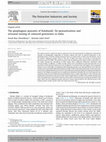
The Extractive Industries and Society, 2016
This paper presents a political economic appraisal of the de-peasantisation of indigenous communi... more This paper presents a political economic appraisal of the de-peasantisation of indigenous communities through an ethnographic exploration of artisanal mining and trade of coloured gemstones in the Kalahandi district of western Odisha (formerly Orissa) in eastern India. It shows that the Khonds, one of the poorest indigenous groups living in this part of India have taken up mining of semi-precious gemstones since the 1990s. This period coincides with the opening of the Indian market of gemstones to the world, alluring this community to often replace their traditional subsistence agriculture with artisanal mining. In addition, a number of other factors have contributed to push more peasants out of agriculture to the informal mining sector for livelihood as it provides them with higher return and quick money. A series of droughts accompanied with deepening agrarian crisis and exploitative caste and class relations have particularly affected the Khond and other tribes of the Kalahandi region. At the same time, the increase in global demands have led to an intensification of informal gemstone mining by the Khonds. However, the indigenous people have not significantly benefitted; although the rate of out-migration has slackened, many are now without land and working in mines as daily wage labourers. This is because the proliferation of mining has also attracted the entry of opportunistic outsiders who collude with the local state, local politicians, caste-leaders and class-elites, police, and bureaucracy to sweep up the profits. This paper shows that the indigenous people continue to remain impoverished as the informal nature of the mining business further pushes them into living precarious lives.
Economic and political weekly
A fter being a student of the discipline and having taught geography in a regional university for... more A fter being a student of the discipline and having taught geography in a regional university for 20 years, it was a most pleasing experience for me to see first an article (Anu Kapur,'Geography in India: A Languishing Social Science', September 11, 2004) and then a discussion on geography in India (Sheela Prasad,
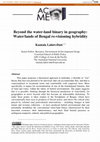
ACME
This paper proposes a theoretical approach to hybridity, a flexible or “wet” theory that does not... more This paper proposes a theoretical approach to hybridity, a flexible or “wet” theory that does not pretend to be universal, that can accommodate flux, and that is contextualised in locational terms and comfortable with empirical facts. More specifically, it argues for reconsideration of one of the foundational binaries, that of land and water, within the rubric of hybrid environments. The paper suggests that it is possible, thinking through the historical production of water/lands, for geographers to move beyond what has become an indissoluble dichotomy. To make these points, it takes readers to the floodplains of Bengal, which have conventionally been seen as products of fluvial action, and shows the critical roles played by colonial (and postcolonial) interventions – including changes in land tenure and revenue collection – to have produced hybrid environments that can potentially destabilize the conventional water-land binary characterised by their uncertain existence, their indet...
Hexagon Series on Human and Environmental Security and Peace, 2011
Abstract This chapter addresses the question of security1 and sustainability2 of water resource m... more Abstract This chapter addresses the question of security1 and sustainability2 of water resource management (WRM) in Bangladesh due to climate change and complex social and political factors including weak governance. It suggests that social networks should play an important role in ensuring security at the micro levels, and the promotion of people-centred water management. Bangladesh, a highly populated country located on the floodplains of the Ganges-Brahmaputra-Meghna Rivers, receives abundant monsoonal ...
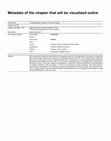
Engineering Earth, 2010
Mining has been the original human endeavor of engineering; tools are an integral part of the pro... more Mining has been the original human endeavor of engineering; tools are an integral part of the project of mining itself. Most contemporary mining projects continue to be characterized by the intensive use of technology and capital, and have come to symbolize the evils of neoliberal development. Consequently, a host of ideologies and approaches to development have battled with each other on the mine sites, especially as they increasingly break new grounds in third world countries. This paper critiques this megaproject of mining from a feminist perspective, and problematizes the interface between mining and gender in a bid to re-humanize the mining landscape. The critique rests on illuminating the naturalization of men through masculinized representations of mining as work, the masculinity of the miner, re-interpretations of gender-selective impacts of mining projects, and on exploring how technology in mining interacts differently with women and men.
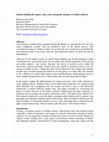
SSRN Electronic Journal, 2006
Coal mining in modern India expanded during the British raj and proved to be one area where indig... more Coal mining in modern India expanded during the British raj and proved to be one area where indigenous women took up productive roles in the labour process. The conventional images of 'Indian women' do not fit in the way women have performed the non-traditional roles in the mines since the mid-nineteenth century till about the time of independence. Analyses of how Indian society in eastern India adopted and resisted modernity under colonialism have stressed the active roles of urban men and the separation of the 'private and public spheres', and women 'learning' the mores of modern society under the benevolent colonial patronage. Studies have also posited a somewhat passive role for women in Indian society, a typification that can be subjected to the critique that feminist scholars have mounted against the failure to accord agency to women. My own research in the collieries of eastern India region using interdisciplinary methodologies reveal a more complex gendered division of labour than what has been described for India. In this paper I explore the differentiation of women and men's roles in the collieries by using marking theory. Marking theory from Jakobsonian linguistics for characterising these different, but overlapping roles for women and men is used as the theoretical framework to explore different gender roles. The paper concludes by reassessing the place of women and men in the Indian collieries, emphasising the great complexity of gendered roles in mining and migrant settlement contexts. The paper deals with the fact that women of particular castes and ethnic groupings joined mining work as against class groupings that attempt to interpret labour in the mines. Thus, the Indian collieries provide ideal examples of a threefold interface of class, caste and gender that is explored by this paper using historical data, official statistics and interviews with women workers.
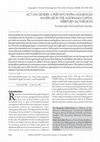
Rural Society, 2008
Intra-household water use and management from a gender perspective has remained a relatively unde... more Intra-household water use and management from a gender perspective has remained a relatively under-researched theme in developed countries. Australia is no exception, with the lack of research particularly evident in the many rural and peri-urban communities. These communities have experienced significant water scarcity in recent years. In this context, this paper explores the potential of water use diaries to explore gender perspectives in Australian intra-household water use. Primarily a methodological paper, it examines the concepts that might inform a water diary examining gendered aspects of intra-household water management and use. Following the research approach to gendered intra-household resource allocation established in developing nation research, the aim is to develop a tool that has the potential to clarify the gender implications within households of current water policies and practices. Albeit a tentative step toward understanding gender aspects of intra-household water use and management, this paper raises a number of issues suggesting this type of research has both practical usefulness and academic importance. Its practical value lies in it capacity to influence the water agencies' ability to target specific 'water user groups' and develop effective public policy in a participatory manner with detailed household information. The academic worth lies in the 'cutting edge' nature of the research as it explores an approach proven in developing nations but as yet narrowly adopted in Australia and other developed countries.










Uploads
Papers by Kuntala Lahiri-Dutt